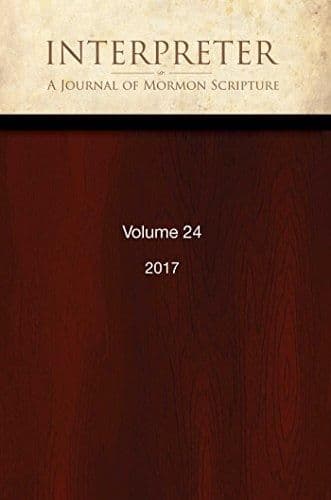Journal
“Arise from the Dust”: Insights from Dust-Related Themes in the Book of Mormon (Part 1: Tracks from the Book of Moses)

Title
“Arise from the Dust”: Insights from Dust-Related Themes in the Book of Mormon (Part 1: Tracks from the Book of Moses)
Publication Type
Journal Article
Year of Publication
2016
Authors
Lindsay, Jeff (Primary)
Journal
Interpreter: A Journal of Latter-day Saint Faith and Scholarship
Pagination
179-232
Volume
22
Abstract
In light of Noel Reynolds’ hypothesis that some material in the Book of Moses may have been present on the brass plates that Nephi used, one may wonder if Nephi or other authors might also have drawn upon the use of chains in the Book of Moses, particularly Satan’s “great chain [that] veiled … the earth with darkness” (Moses 7:26) and the “chains of darkness” (Moses 7:57). Though the phrase “chains of darkness” is not used in the Book of Mormon, 2 Nephi 1:23, quoting Lehi, combines chains and obscurity, where obscurity can have the meaning of darkness. In fact, there may be a Hebraic wordplay behind Lehi’s words when he tells his wayward sons to “come forth out of obscurity and arise from the dust,” based on the similarity between the Hebrew words for “obscurity” and “dust.” The association between dust and chains and several other newly found linkages to Book of Moses material is enriched by a study of Walter Brueggemann on the covenant-related meanings of “rising from the dust” and “returning to the dust” in the Bible, a topic we explore in Part 2.1 Then, after showing how dust-related themes in the Book of Mormon can enhance our understanding of several important passages, we build on that knowledge in Part 3 to “dust off” the most famous chiasmus in the Book of Mormon, where we will show that some apparent gaps and wordy regions in the complex chiastic structure of Alma 36 are more compact and meaningful than we may have realized. Both dust-related themes and themes from the Book of Moses assist in better [Page 180]appreciating the richness of that masterpiece of Hebraic poetry. Overall, a small amount of exploration motivated by Reynolds’ work may have led to several interesting finds that strengthen the case for Book of Moses content on the brass plates and deepen our appreciation of the use of ancient Near Eastern dust themes in the Book of Mormon, that majestic “voice from the dust.”
Subject Keywords
Bibliographic Citation
Terms of use
Items in the BMC Archive are made publicly available for non-commercial, private use. Inclusion within the BMC Archive does not imply endorsement. Items do not represent the official views of The Church of Jesus Christ of Latter-day Saints or of Book of Mormon Central.